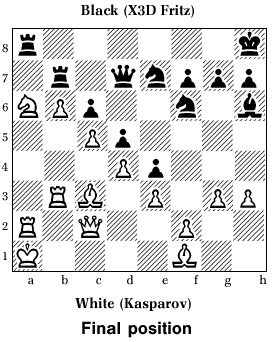
Chess is no different. Indeed, the game is so profound and complex that teamwork is far more likely to succeed than solitary endeavour. Thus, over the years I have employed all manner of coaches, trainers, seconds and analysts to assist me in my preparation. Some have been good, some have been not so good, some have been industrious, some have been bone-idle, but they have all required gentle handling and payment. Finally I have found a helper who answers almost all my needs!
He doesn't eat and he doesn't sleep and is therefore very economical. I can abuse him, give him the most humiliating and degrading tasks, and he sets about them uncomplainingly. As to his ability? Well, he also has just about the sharpest tactical vision of anyone I know. Recently a close relative of my silicon slave, Fritz, played a match against Garry Kasparov, which he drew 2-2. He held the first game comfortably despite having a dodgy position an exchange down. In the second game he shuffled around aimlessly waiting for Garry to blunder, which the great man duly did. In the third my silicon friend lost in a way that only computers know how.
The fourth was a very sharp but short draw - a result that neither camp would have been averse to, given the lucrative prospect of a rematch and another massive dose of publicity.
White:
Kasparov
Black: X3D
Fritz New York, November
16
1. Nf3 Nf6 2. c4 e6 3. Nc3 d5 4. d4 c6 5. e3 a6 An old-fashioned and not particularly good side-line of the Semi-Slav, although it has been employed by Alekhine, Euwe, Reshevsky, Najdorf and other notables. 6.c5! A good move in itself, seizing space, and an excellent choice against a computer - they are not adept in closed positions. 6. ...Nbd7 7. b4 a5?! "This wastes a tempo, and merely encourages White's queenside to advance," according to Harry Golombek in his book of the World Chess Championship, 1948.
Personally, I would be more scathing had it not previously been played by the late, legendary Paul Keres, whose physiognomy adorns the Estonian five kroon note. 8. b5 e5 This liberating advance is the only small consolation for the ruined queenside. 9. Qa4 Qc7 10. Ba3 e4 11. Nd2 Be7 12. b6 Deviating from the Reshevsky-Keres game which continued 12. Be2 h5 13. b6 Qd8 14. h3 Nf8 15. 0-0-0 Ne6? Whereupon Reshevsky launched the combination 16. Ndxe4! Nxe4 17. Nxe4 which could not be taken on account of d5. 12. ...Qd8 13. h3 The stage is set.
Left uninhibited White will win with nb3, nxa5 followed by the advance of the a-pawn. It is very time-consuming but there is absolutely no direct defence to this plan. Black's only hope therefore rests in obtaining vigorous counterplay on the kingside by means of f5 and f4. The machine, however (genius that he is in open positions) is here far too stupid to spot something which would be obvious even to an ordinary club player. 13. ...0-0 14. Nb3 Bd6!? This caused much amusement.
The point is a transparent trick - 15. cxd6 Nxb6 trapping the queen. 15. Rb1 The b-pawn required protection. If 15. Nxa5 Nxb6 16. cxb6 (16. Qb4 Be7!) 16. ...bxa3 17. Qxa3 Qxb6 regains the piece. 15. ...Be7?! Incomprehensible and losing two tempi. Given that the machine has just put the bishop on the diagonal it only made sense to retain it there with 15. ...Bb8 16. Nxa5 Nb8 17. Bb4 Qd7 Not a bad move. The queen ought to be brought into action. 18. Rb2 Qe6 A normal human being would hereabouts play h5 and h4, cramping the kingside, followed by advancing the f-pawn as rapidly as possible.
The outcome of the game would still not be certain although White's chances would be preferable. 19. Qd1 Nfd7! A prelude to the indispensable advance of the f-pawn? 20. a3 Ruling out Nxb6 tricks. 20. ...Qh6 21. Nb3 Bh4 No, apparently. This move makes the kingside harder to advance as White will answer g3 with tempo. 22. Qd2 Stopping Qxe3+ 22. ...Nf6 Further impeding the f-pawn. 23. Kd1 Evacuating the king from danger. 23. ...Be6 Senseless. 24. Kc1 Rd8 More senseless.
25. Rc2 Nbd7 26. Kb2 Nf8 27. a4 Ng6 28. a5 Ne7 Aha. 29. a6 Garry could even have waited with this push. 29. ...bxa6 30. Na5 Rdb8 31. g3 Bg5 32. Bg2 Securing the kingside for now. 32. ...Qg6 33. Ka1 Kh8 Senseless. 34. Na2! Bd7 35. Bc3 Ne8 Ditto. 36. Nb4 Kg8 37. Rb1 Bc8 38. Ra2 Methodically piling up on the a-pawn. Its annexation will end the game. 38. ...Bh6 39. Bf1 Qe6 40. Qd1 Nf6 41. Qa4 Attacking c6. 41. ...Bb7 42. Nxb7 Rxb7 43. Nxa6 And that is about it.
White has a gigantic extra protected passed b-pawn. 43. ...Qd7 44. Qc2 Kh8 45. Rb3

And in a welcome act of euthanasia the Fritz programmers resigned on behalf of the computer, although it was still only showing a relatively small deficit. The position is hopelessly lost as there is nothing to be done about the exchange of major pieces on the a-file followed by the coronation of the b-pawn. A nightmare game for the programmers as it shows that despite the gigantic strides computers have made, in some areas they remain just dumb machines.